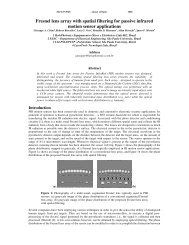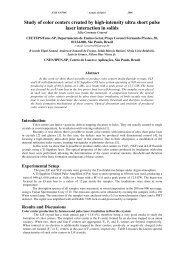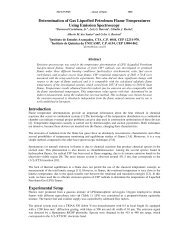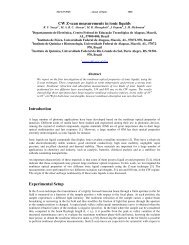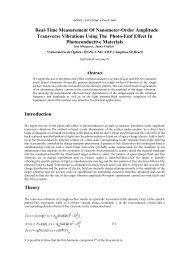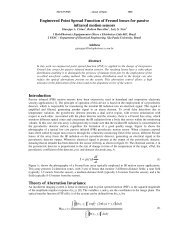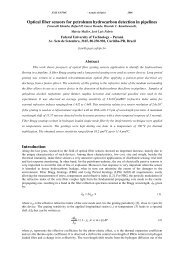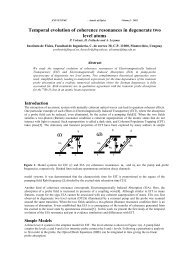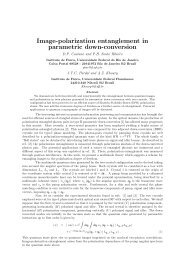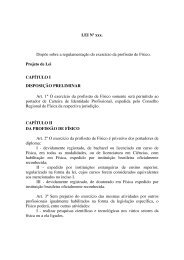Nonlinear optical properties of castor oil Introduction Experimental ...
Nonlinear optical properties of castor oil Introduction Experimental ...
Nonlinear optical properties of castor oil Introduction Experimental ...
You also want an ePaper? Increase the reach of your titles
YUMPU automatically turns print PDFs into web optimized ePapers that Google loves.
XXIX ENFMC - Annals <strong>of</strong> Optics 2006<br />
<strong>Nonlinear</strong> <strong>optical</strong> <strong>properties</strong> <strong>of</strong> <strong>castor</strong> <strong>oil</strong><br />
R. F. Souza 1* , M. A. R. C. Alencar 2 , M. R. Meneghetti 3 , J. M. Hickmann 2<br />
1 Departamento de Eletrônica, Centro Federal de Educação Tecnológica de Alagoas, Maceió,<br />
AL, 57000-000, Brazil<br />
2 Instituto de Física, Universidade Federal de Alagoas, Maceió, AL, 57072-970, Brazil<br />
3 Instituto de Química e Biotecnologia, Universidade Federal de Alagoas, Maceió, AL, 57072-<br />
970, Brazil<br />
* rogerio@loqnl.ufal.br<br />
Abstract<br />
We report on the investigation <strong>of</strong> the nonlinear <strong>optical</strong> <strong>properties</strong> <strong>of</strong> <strong>castor</strong> <strong>oil</strong> using the Z-scan<br />
technique. <strong>Nonlinear</strong> refraction and absorption measurements were performed for two different<br />
laser wavelengths, 514 and 810 nm, in the CW regime, and for 810 nm in femtosecond regime.<br />
The CW results showed that <strong>castor</strong> <strong>oil</strong> has a large negative nonlinear refractive index n 2 = -3.2 x<br />
10 -8 cm 2 /W for the laser wavelength at 514 nm, and this value was about one order <strong>of</strong> magnitude<br />
smaller for excitation tuned at 810 nm. The negative sign and the slow response <strong>of</strong> this<br />
nonlinearity indicate the thermal origin <strong>of</strong> this effect. In the femtosecond regime, it was not<br />
possible to observe a typical Z-scan curve for <strong>castor</strong> <strong>oil</strong>. The nonlinear absorption was absent for<br />
all experimental configurations.<br />
<strong>Introduction</strong><br />
Organic materials have been exploited as a basis for photonic devices due to their large <strong>optical</strong> nonlinearities<br />
and fast response, which can be attributed to light-induced molecule reorientation, incoherent electronic<br />
excitation and thermal lens effect [1]. Besides their intrinsic nonlinear <strong>optical</strong> <strong>properties</strong>, organic materials have<br />
been used in the development <strong>of</strong> colloidal structures containing nanoparticles.<br />
Among the myriad <strong>of</strong> organic materials, the <strong>castor</strong> <strong>oil</strong> is <strong>of</strong> particular interest because <strong>of</strong> its several industrial<br />
applications, such as a key raw-material for the production <strong>of</strong> several commodities like paints, polymers,<br />
lubricants, etc. In terms <strong>of</strong> molecular constitution, <strong>castor</strong> <strong>oil</strong> is a mixture <strong>of</strong> triglycerides, predominantly derived<br />
from a unsaturated and hydroxylated C:18 fatty acid, the ricinoleic acid. Recently, we showed that <strong>castor</strong> <strong>oil</strong> is a<br />
very good stabilizer for colloidal systems containing gold nanoparticles and that these systems present a larger<br />
spatial self-phase modulation effect [2]. However, a more accurate measurement <strong>of</strong> the nonlinear refractive<br />
index and absorption <strong>of</strong> <strong>castor</strong> <strong>oil</strong> have not been performed yet.<br />
In this work, we measured the nonlinear <strong>optical</strong> <strong>properties</strong> <strong>of</strong> <strong>castor</strong> <strong>oil</strong> and investigated its origin using the Z-<br />
scan technique [3]. The measurements were performed for two different excitation wavelengths, 514 nm and<br />
810 nm, in the CW regime, and for 810 nm in femtosecond regime. The origin <strong>of</strong> the observed large nonlinearity<br />
<strong>of</strong> this <strong>oil</strong> is also discussed.<br />
<strong>Experimental</strong> Setup<br />
In the Z-scan technique the transmittance <strong>of</strong> a tightly focused Gaussian beam through a finite aperture in the far<br />
field is measured as a function <strong>of</strong> the sample position z with respect to the focal plane. At each position, the<br />
sample experiences a different light intensity. The nonlinear refraction <strong>of</strong> the sample causes a spatial beam<br />
broadening or narrowing in the far field and thus modifies the fraction <strong>of</strong> light that passes through the aperture<br />
as the sample position is changed. A typical peak-valley (valley-peak) transmittance curve is obtained when the<br />
nonlinear refractive index <strong>of</strong> the medium is negative (positive). In the limit where the sample can be considered<br />
thin, compared to the beam Rayleigh length (L< z 0 ), it is possible from the peak to valley variation <strong>of</strong> the<br />
measured transmittance curve to evaluate the maximum nonlinear phase-shift and hence, knowing the incident<br />
laser power, to obtain the nonlinear refractive index n 2 [3,4]. Removing the aperture in the far field it is possible
XXIX ENFMC - Annals <strong>of</strong> Optics 2006<br />
to perform nonlinear absorption measurements. Such Z-scan traces are expected to be symmetric with respect to<br />
the focal point (z = 0) where they exhibit a minimum transmittance in the case <strong>of</strong> nonlinear absorption<br />
(multiphoton absorption) and a maximum for the saturation absorption. For media exhibiting both nonlinear<br />
refraction and absorption <strong>properties</strong>, a closed aperture Z-scan measurement is sensitive to both effects. Dividing<br />
the closed aperture data by the open aperture one yields a Z-scan trace typical <strong>of</strong> a purely refractive nonlinearity<br />
[3].<br />
The experimental setup used to measure the nonlinear refractive index and absorption <strong>of</strong> <strong>castor</strong> <strong>oil</strong> in this work<br />
is depicted in the Figure 1. A CW Argon laser (Ti:sapphire laser) operating at 514 nm (810 nm) was used as a<br />
light source. The laser beam was modulated by a chopper and focused onto the sample by a convergent lens <strong>of</strong><br />
7.5 cm focal length. The sample consisted <strong>of</strong> a 1 mm quartz cuvette within <strong>castor</strong> <strong>oil</strong>. It was mounted on a<br />
translation stage and moved around the lens focus (z = 0) by a computer controlled stepper motor. The light<br />
transmittance was then measured by a closed-aperture photodetector as a function <strong>of</strong> the sample position. The<br />
detected signal was amplified by a lock-in amplifier and then processed by a computer. <strong>Nonlinear</strong> absorption<br />
measurements were performed using the same experimental setup but using an opened aperture configuration. In<br />
femtosecond regime, the Ti:sapphire laser was operated mode locked, producing pulses <strong>of</strong> 200 fs, at a repetition<br />
rate <strong>of</strong> 76 MHz. Using a pulse selector, the light beam was modulated. In this case, the pulse repetition rate was<br />
reduced to the range <strong>of</strong> 100 Hz to 10 kHz.<br />
Figure 1: <strong>Experimental</strong> setup for <strong>optical</strong> nonlinearity measurements using Z-scan technique.<br />
Results and Discussions<br />
The linear UV-VIS absorption spectrum <strong>of</strong> <strong>castor</strong> <strong>oil</strong> is presented in Figure 2. As can be seen in this figure, this<br />
<strong>oil</strong> presents a gap in the UV-blue region and it is almost transparent in the near infrared region. The laser<br />
wavelengths used in our experiments are also indicated in this figure. Note that, the linear absorption coefficient<br />
<strong>of</strong> <strong>castor</strong> <strong>oil</strong> is larger at 514 nm than at 810 nm.<br />
Absorption coefficient (cm -1 )<br />
6<br />
5<br />
4<br />
3<br />
2<br />
1<br />
514 nm<br />
0<br />
300 400 500 600 700 800<br />
Wavelength (nm)<br />
810 nm<br />
Figure 2: Linear absorption spectrum <strong>of</strong> <strong>castor</strong> <strong>oil</strong>.
XXIX ENFMC - Annals <strong>of</strong> Optics 2006<br />
Figure 3 shows the typical normalized transmittance, closed aperture, as a function <strong>of</strong> the sample position, for<br />
CW laser excitation tuned at 514 nm. From the observed transmittance variation, the <strong>castor</strong> <strong>oil</strong> nonlinear<br />
refractive index was evaluated as n 2 = -3.2 x 10 -8 cm 2 /W. Although this value is smaller than other materials,<br />
such as photorefractive crystals and Chinese tea, this nonlinearity is much larger than several organic liquids as<br />
DMSO and CS 2 , for example.<br />
1,3<br />
Normalized Intensity<br />
1,2<br />
1,1<br />
1,0<br />
0,9<br />
0,8<br />
0,7<br />
-8 -4 0 4 8<br />
1,3<br />
z/z 0<br />
Figure 3: Z-scan curve for <strong>castor</strong> <strong>oil</strong> at 514 nm in the CW regime, P laser = 10 mW.<br />
A typical Z-scan curve obtained for CW laser excitation tuned at 810 nm is presented in Figure 4. In this case,<br />
the measured nonlinear refractive index was much smaller than it was in the former case, n 2 = - 3.3 x 10 -9<br />
cm 2 /W. This happens because the energy <strong>of</strong> the excitation at 514 nm is nearer to the gap energy <strong>of</strong> the <strong>castor</strong> <strong>oil</strong>,<br />
and hence it is expected that the linear absorption and the nonlinear <strong>properties</strong> <strong>of</strong> this medium to be larger than it<br />
is when the laser is tuned far from the resonance.<br />
Normalized Intensity<br />
1,2<br />
1,1<br />
1,0<br />
0,9<br />
0,8<br />
0,7<br />
-8 -4 0 4 8<br />
z/z 0<br />
Figure 4: Z-scan curve for <strong>castor</strong> <strong>oil</strong> at 810 nm in the CW regime, P laser = 177 mW.<br />
When the laser was operated in femtosecond regime, no Z-scan curve was obtained in the range <strong>of</strong> 100 Hz to 10<br />
kHz repetition rate. This result indicates that the slow nonlinear effects, such thermal lens, give the most<br />
important contributions for the large nonlinearity that this medium presents.<br />
We also performed the z-scan measurements with the opened aperture configuration. In this case, nonlinear<br />
absorption was not observed at any experimental conditions exploited in this work.
XXIX ENFMC - Annals <strong>of</strong> Optics 2006<br />
Conclusions<br />
We have carried out an investigation <strong>of</strong> the nonlinearity <strong>optical</strong> <strong>properties</strong> <strong>of</strong> <strong>castor</strong> <strong>oil</strong> using the Z-scan<br />
technique for two excitation wavelengths, 514nm and 810 nm, in the CW regime, and for 810 nm in the<br />
femtosecond regime. Large nonlinear refractive indexes were obtained for both wavelengths, in the CW<br />
regime. However, in the femtosecond regime, it was not possible to observe a typical Z-scan curve for<br />
<strong>castor</strong> <strong>oil</strong>. This result suggests that this nonlinearity is mainly due to thermal effects. The nonlinear<br />
absorption was absent for all experimental configurations.<br />
Acknowledgements<br />
The authors thank the Brazilian agencies Conselho Nacional de Desenvolvimento Científico e Tecnológico<br />
(CNPq), Fundação de Amparo à Pesquisa do Estado de Alagoas (FAPEAL), Coordenação de Aperfeiçoamento<br />
de Pessoal de Nível Superior (CAPES), Nan<strong>of</strong>oton network, Nanoanálise e Diagnóstico network, and<br />
Financiadora de Estudos e Projetos (FINEP) for financial support.<br />
References<br />
[1] P. N. Prasad, D. J. Williams, <strong>Introduction</strong> to <strong>Nonlinear</strong> Optical Effects in Molecules and Polymers, Wiley-<br />
Interscience, New York (1991).<br />
[2] M. A. R. C. Alencar, C. M. Nascimento, M. G. A. da Silva, M. R. Meneghetti and J. M. Hickmann, Large<br />
Spatial Self-Phase Modulation in Castor Oil Enhanced by Gold Nanoparticles, Proceedings <strong>of</strong> SPIE 6103,<br />
6 (2006).<br />
[3] M. Sheik-Bahae, A. A. Said, T-H Wei, D. J. Hagan and E. W. Van Stryland, Sensitive Measurement <strong>of</strong><br />
Optical <strong>Nonlinear</strong>ities Using a Single Beam, IEEE J. Quantum Electron. 26, 760 (1990).<br />
[4] I. P. Nikolakakos, A. Major, J. S. Aitchison and P. W. E. Smith, Broadband Characterization <strong>of</strong> the<br />
<strong>Nonlinear</strong> Optical Properties <strong>of</strong> Common Reference Materials, IEEE J. <strong>of</strong> Sel. Top. In Quantum Electron.<br />
10, 1164 (2004).



